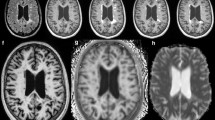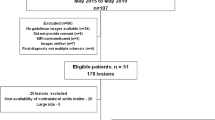Abstract
Magnetisation transfer (MT) is a recently introduced technique for assessing the water content of tissues in vivo and its relationship to macromolecules or membranes. It has been suggested that MT could provide indirect evidence of the characteristics of multiple sclerosis (MS) lesions (oedema, demyelination, or gliosis). Our aims were to characterise brain MS lesions and to compare the magnetisation transfer ratio (MTR) values of lesions with different patterns of contrast enhancement. In patients with MS we measured the MTR of 65 gadolinium-enhancing and 292 nonenhancing lesions. Using the equation published by Dousset et al. we studied 29 patients with clinically definite MS and 10 healthy controls. Lesions had significantly lower MT than the normal-appearing white matter of the patients or the normal white matter of healthy controls. There was no difference in the MTR of enhancing and nonenhancing lesions. Enhancement was homogeneous in 45 and ring-like in 20 lesions; MTR values were lower in the latter. These findings are presumably related to the differences in pathological features of enhancing (different amounts of proteins and inflammatory cells, oedema and demyelination) and nonenhancing (gliosis, demyelination and axonal loss) lesions.
Similar content being viewed by others
References
Lundbom N (1992) Determination of magnetization transfer contrast in tissue: an MR imaging study of brain tumors. AJR 159: 1279–1285
Wolff SD, Balaban RS (1989) Magnetization transfer contrast (MTC) and tissue water proton relaxation in vivo. Magn Reson Med 10: 135–144
Balaban RS, Ceckler TL (1992) Magnetization transfer contrast in magnetic resonance imaging. Magn Reson Q 2: 116–137
Larsson HBW, Frederiksen J, et al (1989) Assessment of demyelination, edema, and gliosis by in vivo determination of T1 and T2 in the brain of patients with acute attack of multiple sclerosis. Magn Reson Med 11:337–348
Fullerton DG, Potter JL, Dornbluth NC (1982) NMR relaxation of protons in tissues and macromolecular water solutions. Magn Reson Imaging 7:1209–1226
Dousset V, Grossman RI, et al (1992) Experimental allergic encephalomyelitis and multiple sclerosis: lesion characterization with magnetization transfer imaging. Radiology 182:483–491
Mittl RL Jr, Gomori JM, Schnall MD, Holland GA, Grossman RI, Atlas SW (1993) Magnetization transfer effects in MR imaging of in vivo intracranial hemorrhage. AJNR 14:881–891
McDonald WI, Miller DH, Barnes D (1992) The pathological evolution of multiple sclerosis. Neuropathol Appl Neurobiol 18:319–334
Poser CM, Paty DW, Scheinberg L, et al (1983) New diagnostic criteria for multiple sclerosis: guidelines for research protocols. Ann Neurol 13:227–231
Kurtzke JF (1983) Rating neurological impairment in multiple sclerosis: an expanded disability status scale (EDSS). Neurology 33:1444–1452
Gass A, Barker GJ, Kidd D, et al (1994) Correlation of magnetization transfer ratio with clinical disability in multiple sclerosis. Ann Neurol 36:62–67
Paty DW (1987) Magnetic resonance imaging in demyelination. In: Kim SU (ed) Myelination and demyelination implications for multiple sclerosis. Plenum, New York, pp 259–272
Katz D, Taubenberger JK, Cannella B, et al (1993) Correlation between magnetic resonance imaging findings and lesion development in chronic active multiple sclerosis. Ann Neurol 34:661–669
Bruck W, Schmied M, Suchanek G, et al (1994) Oligodendrocytes in the early course of multiple sclerosis. Ann Neurol 35:65–73
Nesbit GM, Forbes GS, Scheithauer BW, et al (1991) Multiple sclerosis: histopathology and MR and/or CT correlation in 37 cases at biopsy and three cases at autopsy. Radiology 180:467–474
Hawkins CP, Munro PMG, MacKenzie F, et al (1990) Duration and selectivity of blood-brain barrier breakdown in encephalomyelitis studied by gadolinium-DTPA and protein markers. Brain 113:365–378
Grossman RI (1994) Magnetization transfer in multiple sclerosis. Ann Neurol 36:S97-S99
Author information
Authors and Affiliations
Rights and permissions
About this article
Cite this article
Campi, A., Filippi, M., Comi, C. et al. Magnetisation transfer ratios of contrast-enhancing and nonenhancing lesions in multiple sclerosis. Neuroradiology 38, 115–119 (1996). https://doi.org/10.1007/BF00604792
Received:
Accepted:
Issue Date:
DOI: https://doi.org/10.1007/BF00604792




